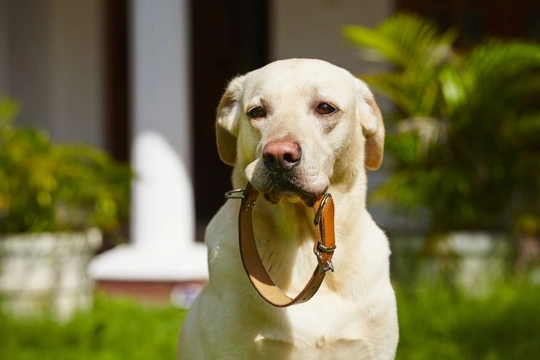
Dog Collar Chafing: Prevention & Treatment
Wearing a collar is a simple fact of life for the vast majority of dogs, and even dogs that are walked with a harness usually wear a collar too to hold their identification tags, and most dogs aren’t even really aware of their collar after they pass the puppy stage, because they have got so used to it.
However, if your dog’s collar rubs, chafes or pinches, your dog will be all too aware of this fact, and it will feel sore and uncomfortable and of course, be even worse if pressure is applied to the collar by walking on the lead.
Chafing and rubbing from your dog’s collar is usually entirely preventable, but it can also be difficult to realise when a problem of this type is developing, because the collar covers the area of the neck that is most likely to be affected.
In this article, we will look at some of the problems and factors that can lead to your dog’s collar chafing or rubbing, how to deal with the issue if it does arise, and how to prevent it from happening in the first place. Read on to learn more.
Checking your dog’s neck and collar
You should take your dog’s collar off them regularly, even if your dog always wears their collar even when at home – every couple of days, remove the collar and check it is still in good condition, wipe or clean it off if necessary, and check that your dog’s neck and throat look ok.
What to do if your dog’s collar has chafed their neck
If you find that the fur around and underneath your dog’s collar has become sparse or broken, this often precedes chafing, so stop using the collar and find a more suitable alternative, whilst leaving the collar off until your dog’s fur has regrown. In the meantime, use a harness instead, and don’t forget to attach your dog’s ID tags.
If the skin of your dog’s neck is chafed, sore or otherwise appears to be damaged – you should once again stop using the collar until your dog’s neck heals, and look at alternatives that won’t cause the problem in future. You may also want to speak to your vet about the right type of collar to choose, and particularly if your dog’s skin is inflamed, red, or actually has abrasions from the collar.
What causes collars to chafe?
Picking the most appropriate collar for your dog is the key to keeping them comfortable and avoiding chafing, and what makes for the best collar for any given dog depends on their conformation and also, their behaviour on the lead.
Pulling on the lead
If your dog pulls on the lead, this will lead to pressure around their neck (at the front in particular) which can both damage their neck itself and cause chafing and pinch points. Using a harness that distributes the pressure of a pulling dog more evenly can help with this.
Pinching
Some collars may pinch at their closure, such as the buckle or catch, particularly in combination with pulling on the lead. Always ensure that your dog’s collar hasn’t caught on their fur, and can move a little to avoid problems. Look out for any potential pinch points, and choose a collar that doesn’t produce one main area of pressure.
The tightness of the collar
A collar that is too tight will chafe, rub and cause pain, and this is most commonly an issue in fast-growing pups who will need their collars to be adjusted or replaced regularly as they grow.
To get the correct fit for your dog’s collar, it should be snug but not tight – you should be able to get the flat of two fingers comfortably between the collar and your dog’s neck, but any more than this is likely to be too loose.
A collar that is rough or stiff
If the collar is very stiff – such as a new untreated leather collar – or if it is rough, as can be the case with some synthetic collars, particularly around the ends and edges, it will soon cause chafing and rubbing to the fur and skin of the neck. A good collar should be smooth and supple, without rough areas or too much stiffness.
A dirty collar
Dogs can get into a right mess when out on their walks, often getting plastered in muck and mud simply walking around the block! If mud and grime make your dog’s collar dirty, this will also mean that dirt will work its way under the collar, where it will rub and chafe at your dog’s neck.
Wash your dog’s collar regularly, clean them off after walks, and check the fur under their collar and brush it out when you groom your dog.
Using the wrong type of collar
The shape and build of your dog will mean that some collars are more appropriate for them than others, and choosing the right style of collar will help to ensure it is a good fit for them, and won’t cause any problems.
The collar should be wide enough to distribute pressure from the lead evenly without pinching, but not so wide that feedback from the lead doesn’t have an effect on your dog.
Cushioned or padded collars can help to prevent chafing, but cushioning tends to flatten out over time, so as ever, check the collar and your dog’s neck regularly to make sure everything is ok.



